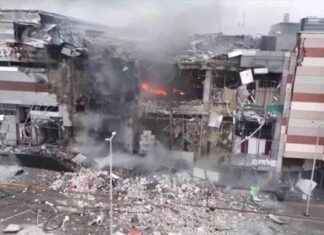MEXICO CITY , Mexico has returned to mass commemorations of the Day of the Dead after traditional graveyard visits were banned last year due to the coronavirus pandemic.
The one-year break showed that the tradition does not die. Many families celebrated the death of loved ones with home altars, while others snuck into cemeteries.
Gerardo Tapia Guadarrama joined others at the cemetery on Sunday as he visited Juan Ignacio Tapia’s grave. He died in May 2020 from thrombosis.
Even though Mexico’s cemeteries were closed last year due to the spread of the virus, the tradition is so strong that his son still visited the Valle de Chalco cemetery in eastern Mexico City to see him.
Tapia Guadarrama replied slyly, “Lat year it had been prohibited.” Many graveyards have low walls that can be jumped.
He said, “To live is not to forget.” “What they (the deceased) most desire is to be visited by those they are close to in their lives.”
This holiday is to remember those who have died in an accident on Oct. 31; it will continue Nov. 1 for those who were in their childhood and those who died later in life on Nov. 2.
Family members decorate graves with orange marigolds and clean them daily. Relatives light candles and offer food and drink offerings to their loved ones at both home and in cemeteries.
A special altar was built in Mexico City to honor those who had died from COVID-19. Family members were allowed to enter a secure area and given equipment to print photos of loved ones. They could also handwrite messages on a wall with their messages.
In a country where almost all extended family members were affected by coronavirus, it was a solemn and quiet moment of remembrance.
Mexico has more than 288,000 confirmed deaths. However, probable coronavirus mortalities listed on death certificates indicate a toll closer at 440,000. This is the fourth highest number in the world.
COVID-19 was especially cruel in a country where relatives are often present to help people die, and loved ones were removed from their homes in plastic tents so they could die in isolation.
Gina Olvera spoke of her father who was a victim of coronavirus. “The only thing that I could say to him, was, ‘Do what the doctors tell you.'” Gina Olvera stated. “That was all I could say to him.” Olvera stated that she told her father as she taped his photograph to the memorial, “Well you didn’t make the cut, but you are still here with us.”
One woman wept while she pinned up photos of her relatives. Dulce Moreno was calm and sad as she pinned up photos of her uncle, Pedro Acosta Nunez (both of whom died from complications of COVID-19).
Moreno stated, “The house feels empty now that he (the grandfather) is gone. We feel lost.”
It was a joyous return to public activities, such as public altars or the Hollywood-style Day of the Dead Parade that Mexico City adopted to imitate a fictional march in the 2015 James Bond film “Spectre.”
Otilia Ochoa, who was a homemaker and took photos of the flowers-adorned offerings at the coronavirus memorial said that these days were not sad. Ochoa stated that it was good to regain liberty and the contact lost during the pandemic.
Tens of thousands of Mexican City residents gathered on Sunday along the main boulevard to see the parade of dancers, skeletons, and floats.
Although there were not many references to coronavirus, the parade featured a section of skeleton-dressed performers representing Mexico City’s street vendors and traders.
In kicking off the parade, Paola Felix Diaz, Mexico City Tourism Secretary, stated that “We are here for life!”
The pandemic has not affected more risky group activities, such as trick-or-treating and Halloween-style costume parties. Children took the opportunity to dress in Mexican-style Day of the Dead costumes, such as the skull-like Catrinas or red-clad Guards from the Netflix series “Squid Game.”
Mexico has had a long-standing attitude to death that is more inclusive and social than many other countries. Mexico has many elaborate funerals that last several days. They gather entire neighborhoods and extended family members for food, prayer, and the purpose of remembering.








